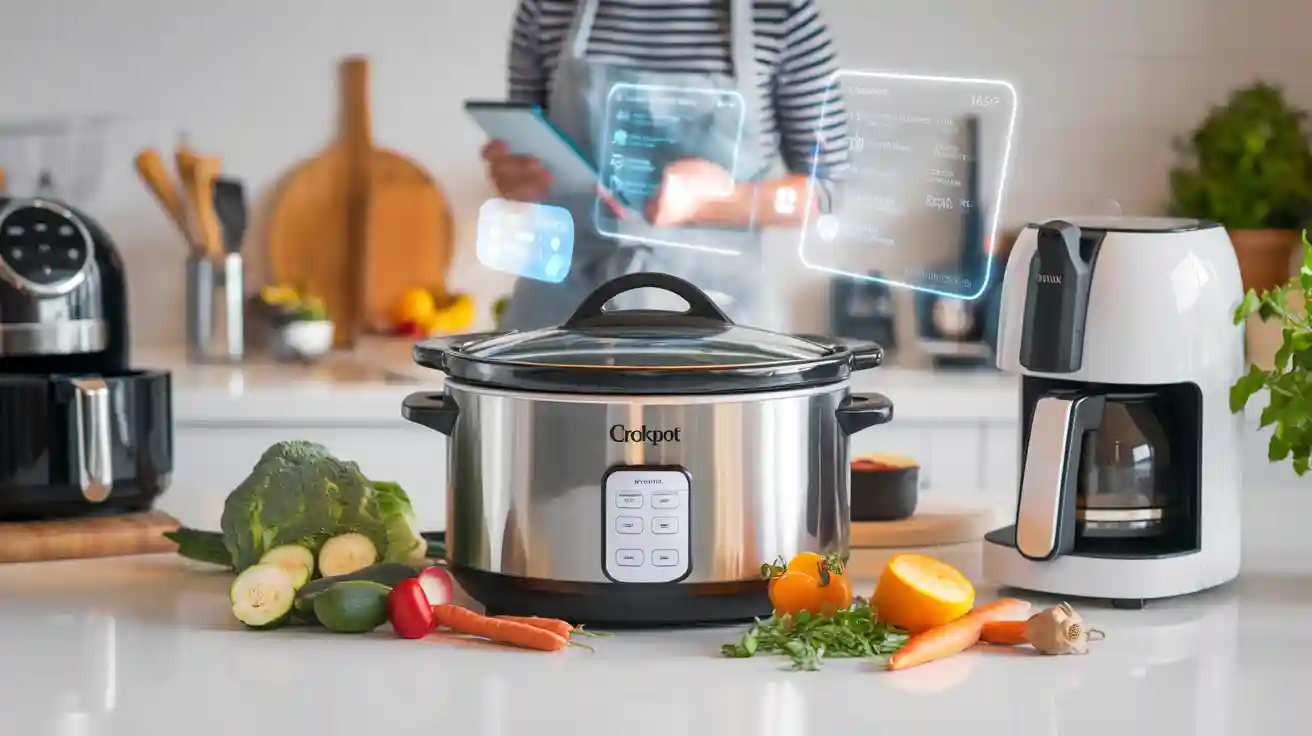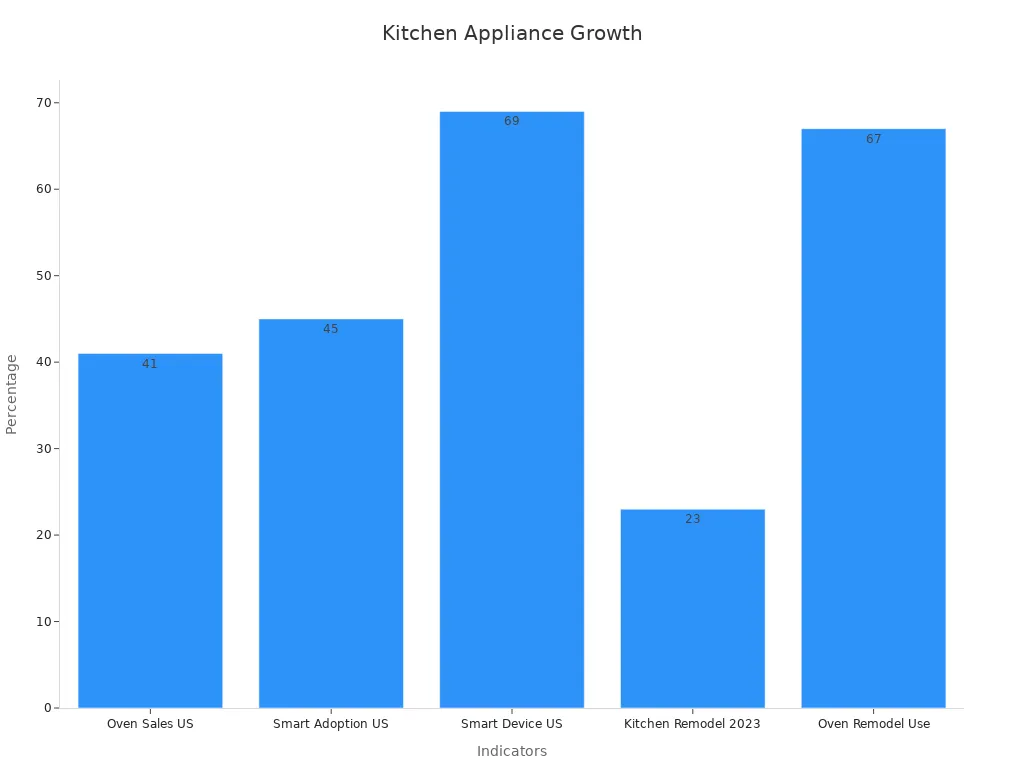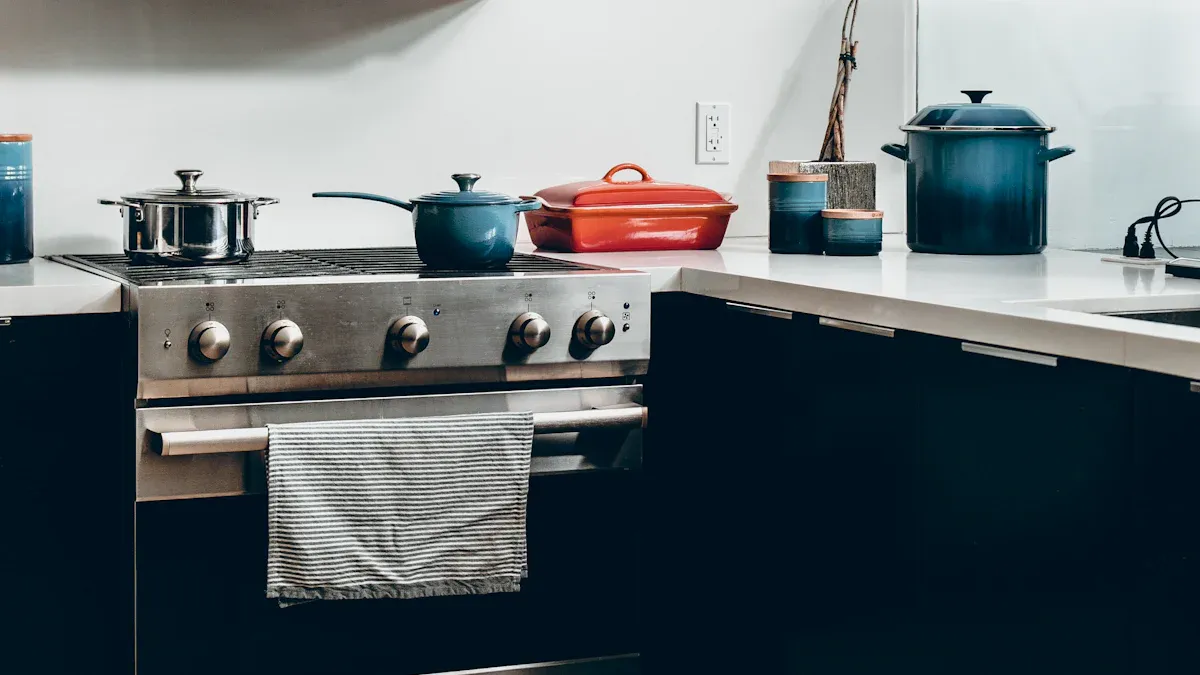
Crockpot multicookers combine functions like slow cooking, pressure cooking, and air frying in one appliance. This innovation meets growing consumer demand for convenience and versatility.

Many households now choose a crockpot multicooker to save time and space in the kitchen.

How Crockpot Multicookers Are Changing Kitchen Appliances
Multifunctionality and Innovation
Crockpot multicookers have redefined what a kitchen appliance can do. These devices combine several cooking methods, such as slow cooking, pressure cooking, rice cooking, and even baking, into one compact unit. Multi-function cookers now allow users to sauté, sear, and steam with the push of a button. This versatility means families can prepare a wide range of meals without switching between different appliances.
Manufacturers have introduced smart features that make these appliances even more innovative. Many crockpot multicookers now offer Wi-Fi or Bluetooth connectivity, letting users control cooking times and temperatures from their smartphones. Built-in recipe libraries and step-by-step guidance help both beginners and experienced cooks achieve great results. Some models even support “pot-in-pot” cooking, which allows multiple dishes to cook at the same time.
Tip: Multi-function cookers can reduce meal prep time and save valuable counter space, making them ideal for busy households.
The integration of smart technology also supports sustainability. Energy-efficient designs and eco-friendly materials are becoming more common, reflecting a shift toward greener kitchens. These advancements show how multi-function cookers are leading the way in kitchen innovation.
Impact on Home Cooking Routines
The rise of the multi-cooker has changed daily cooking habits for many families. During the COVID-19 pandemic, more people cooked at home and needed appliances that could handle a variety of tasks. Crockpot multicookers became essential tools, helping users prepare comfort food and healthy meals with less effort.
Surveys show that over 70% of consumers value the multifunctionality of these devices. Younger generations, such as Millennials and Gen Z, prefer appliances that save space and offer features like app connectivity and air frying. Families with children appreciate the time-saving benefits, while single-person households look for compact, easy-to-clean models.
Multi-function cookers also support healthier eating. Features like air frying and steaming help users prepare low-oil meals. The ability to cook different cuisines encourages culinary exploration and makes it easier to try new recipes. Many people now rely on their crockpot multicooker to balance cooking with work, school, and other responsibilities.
Note: The demand for energy-efficient and programmable appliances continues to grow as consumers seek convenience and sustainability in their kitchens.
These changes highlight how multi-function cookers are not just gadgets but essential partners in modern home cooking.
The Evolution of Slow Cooking: From Crockpot to Multi-Cooker
The Origins of the Crockpot Slow Cooker
The story of the slow cooker began in the 1950s with Irving Naxon’s invention, the Naxon Beanery. Inspired by a traditional Jewish stew, this device cooked food slowly over many hours. Rival Manufacturing acquired the design in 1970 and launched it as the Crock-Pot in 1971. The original slow cooker featured a removable crock and simple controls. Families could prepare meals in the morning and return home to a hot dinner. This innovation became especially popular with working women in the 1970s. Rival’s home economics team created recipes to help families use the slow cooker for nutritious and affordable meals. The slow cooker quickly became a staple in American kitchens.
Advancements in Slow Cooker Technology
Over the decades, slow cookers have changed a lot. Early models used analog controls and basic heating elements. Newer slow cookers now offer digital timers, programmable settings, and auto-warm features. Some slow cookers include wraparound heating for even cooking. Manufacturers have also added larger capacities to support meal prepping and batch cooking. Many slow cookers now appeal to tech-savvy users with smart connectivity and remote control options. These advancements make slow cooking easier and more reliable. Busy households and health-conscious users benefit from these improvements, as slow cookers support a wide range of recipes and cooking styles.
The Rise of the Multi-Cooker
The introduction of the multi-cooker marked a major shift in kitchen appliances. In 2010, the Instant Pot combined pressure cooking, slow cooking, rice cooking, steaming, warming, and sautéing in one device. Later models added features like air frying and yogurt making. The multi-cooker meets the demand for convenience and versatility. Market research shows that multi-cookers have become popular for their ability to save time and space. Companies like Philips, Breville, and Tefal continue to innovate, adding smart technology and new functions. The global market for multi-cookers is growing, with North America leading in adoption. The multi-cooker now stands as a symbol of modern slow cooking, blending tradition with advanced technology.
Crockpot Multicooker vs. Traditional Slow Cooker and Pressure Cooker

Core Features and Cooking Methods
Crockpot multicookers, traditional slow cookers, and pressure cookers each offer unique cooking experiences. The table below highlights their main differences:
| Feature | Pressure Cooker / Multi-cooker | Traditional Slow Cooker |
|---|---|---|
| Cooking Time | Very fast (e.g., stew in 30-45 minutes) | Very slow (e.g., stew in 4-8 hours) |
| Heat Method | High-pressure steam; pressure builds inside | Low, steady, direct heat; slow steaming |
| Liquid Usage | Requires minimal liquid; little evaporation | Requires more liquid; some evaporates |
| Flavor Development | Flavors meld quickly; less browning unless sauté used | Flavors meld slowly; richer caramelization |
| Texture Outcomes | Very tender but risk of overcooking to mushiness | Excellent fall-apart tenderness; risk of dry meat if overcooked lean cuts |
| Energy Efficiency | More efficient due to shorter cook times | Uses low wattage over longer periods |
| Safety | Modern models have multiple safety features | Generally safe; suitable for unattended cooking |
| Ease of Use | Steeper learning curve; pressure release needed | Very easy; set and forget |
| Multifunctionality | Often multi-cookers (pressure cook, slow cook, sauté) | Dedicated slow cookers; some with browning |
| Attention Needed | Attention during heating and pressure release | Minimal; can check and stir food anytime |
| Cooking Temperatures | Higher temps (~250°F/121°C) | Lower temps (~170-280°F/77-138°C) |
A slow cooker uses low heat over many hours, making it ideal for tenderizing tough meats and developing rich flavors. A pressure cooker, often part of a multicooker, cooks food quickly with high-pressure steam. The multicooker combines both methods, but its slow cook function may differ from a traditional slow cooker, especially in heat distribution and evaporation.
Benefits and Drawbacks of Each Appliance
Each appliance offers specific advantages and limitations. Consumer reports and technical tests reveal the following:
| Aspect Tested | Evidence of Benefits and Drawbacks |
|---|---|
| Taste and Tenderness | Staffers prepare actual meals and evaluate the quality of food, providing direct evidence of cooking performance. |
| Convenience Factors | Evaluation of control clarity and ease of programming highlights user-friendliness and potential usability issues. |
| Durability | Assessment of the interior pot coating durability indicates long-term reliability and maintenance concerns. |
- Stovetop pressure cookers deliver fast results and high pressure, but they require more skill and attention.
- Electric pressure cookers and multicookers offer programmable settings and safety features, making them easier for most users.
- A slow cooker stands out for its simplicity and reliability. Users can set it in the morning and return to a ready meal.
- Some multicookers may not match the slow cooker’s performance for all-day simmering or delicate recipes.
- Durability and ease of cleaning vary by model, especially with nonstick coatings.
Tip: For hands-off, all-day cooking, a slow cooker remains the top choice. For speed and versatility, a multicooker or pressure cooker excels.
Market Trends and Consumer Shifts in Multi-Cooker Adoption
Changing Preferences and Cooking Habits
Consumers now seek kitchen appliances that offer convenience, health benefits, and energy efficiency. Many people choose multicookers because they want to cook at home more often and eat healthier meals. Several factors drive this shift:
- People want to save time and reduce effort in meal preparation.
- Health and nutrition awareness encourage a move from packaged foods to homecooked dishes.
- Rising disposable incomes allow families to invest in advanced kitchen technology.
- Urbanization and smaller living spaces increase demand for compact, multifunctional appliances.
- Social media and cooking shows inspire new culinary habits and boost interest in home cooking.
Note: The home use segment leads the market, as busy families and individuals look for ways to simplify daily routines.
Brand Competition and Product Innovation
Manufacturers compete by introducing new features and improving user experience. Instant Pot and Crock-Pot often attract the same buyers, showing strong brand rivalry. Sales events like Amazon Prime Day highlight this competition, with multicookers ranking among top-selling items. Brands use real-time consumer data to track trends, adjust strategies, and launch innovative products. Companies like Khind analyze brand awareness and consumer perception to guide product development and stay ahead of competitors.
Demographics and Usage Patterns
Multicooker adoption varies by region and demographic group:
- North America leads, driven by culinary trends and social media influence.
- Europe values technology, energy efficiency, and fast-paced lifestyles.
- Asia-Pacific sees rapid growth, especially in China and Japan, due to rising incomes and urbanization.
- Latin America and the Middle East combine traditional cooking with modern appliances.
Younger generations, such as Millennials and Gen Z, prefer smart, space-saving models. Families and urban dwellers choose multicookers for their versatility and ease of use.
Practical Benefits of Crockpot Multicookers for Home Cooks
Convenience and Time Efficiency
Crockpot multicookers help busy families and individuals save time in the kitchen. These appliances combine several cooking functions, which means users can prepare meals quickly and easily. Many models offer programmable timers and automatic switches to keep food warm. This allows users to set up ingredients in the morning and return home to a hot meal. The compact design saves counter space and reduces the need for multiple devices.
- Instant pots reduce cooking times by combining pressure cooking, slow cooking, and other methods.
- Working adults and parents use these devices to make healthy meals with little preparation.
- Multifunctionality and portability make them ideal for small kitchens.
- Users can cook lean proteins, vegetables, and grains quickly.
- New features improve convenience and energy efficiency.
- Slow cookers with locking lids and easy controls support meal prep and transport.
Tip: Many crockpot multicookers let users prepare ingredients ahead of time, making meal planning simple and stress-free.
Versatility in Meal Preparation
Home cooks enjoy the flexibility that these appliances provide. Crockpot multicookers handle a wide range of recipes, from soups and stews to rice and steamed vegetables. Some models allow users to sauté, bake, or even air fry. This versatility supports different cooking styles and dietary needs. Families can prepare one-pot meals, batch cook for the week, or try new cuisines without extra equipment.
Cooking Results and Recipe Options
The cooking results from a crockpot multicooker often surpass those of single-function appliances. The table below shows how different cooking methods expand recipe options and improve outcomes:
| Cooking Method | Best Recipe Types & Uses | Key Benefits & Improvements in Cooking Results |
|---|---|---|
| Slow Cooker | Large cuts of meat, hearty soups, root vegetables, one-step meals, potlucks | Tenderizes meat, infuses flavors, allows stirring, creates golden edges, simple and travel-friendly |
| Pressure Cooker | Ground meats, one-pot pastas, seafood, rice, beans, leafy greens, quick meals | Cooks up to 70% faster, multi-functional, no thawing needed, no soaking for beans, one-touch healthy cooking |
| Multicooker | Combines slow and pressure cooking, versatile recipes, pot-in-pot, frozen ingredients | Reduces cleanup, reheats, keeps food warm, combines pressure cooking with grilling, supports meal prepping |
These features help users create delicious meals with less effort and more variety.
The Future of Slow Cooking and Multi-Cooker Technology
Integration of Smart Features
Smart features now play a key role in the evolution of crockpot multicookers. Leading brands like Crock Pot, Instant Appliances, and Philips have introduced models with Wi-Fi connectivity, app-controlled programs, and AI-powered cooking. These features allow users to monitor and adjust cooking from their smartphones. Automated cooking programs use sensors for precise temperature control, which helps deliver consistent results every time.
Many new multicookers offer advanced options such as sous vide, yogurt making, and energy-efficient designs. Busy families and health-conscious consumers benefit from these innovations. Smart features also support sustainability by reducing energy use and waste. The market study highlights that these improvements make cooking easier and more efficient, which drives adoption among urban households.
Note: Smart multicookers now combine convenience, precision, and eco-friendly design, making them attractive for modern kitchens.
Predictions for Kitchen Appliance Trends
Industry forecasts show strong growth for multicookers and slow cookers. The global multicooker market is expected to grow from $1.47 billion in 2025 to $2.14 billion by 2030, with a CAGR of 7.9%. This growth comes from rising demand for convenience, health-focused cooking, and advanced technology.
| Trend | Description |
|---|---|
| Modular Design | Appliances with customizable parts and functions |
| Connectivity | Wi-Fi, app control, and voice command integration |
| Precision Cooking | Features like sous vide and programmable settings |
| Sustainability | Energy-efficient and eco-friendly materials |
| Compact Design | Space-saving models for urban and modular kitchens |
Manufacturers focus on premium aesthetics, user-friendly controls, and multifunctionality. Urbanization, higher incomes, and a shift to home-cooked meals drive these trends. The Asia-Pacific region is set for rapid growth as more people seek smart, time-saving appliances. Recent product launches show a move toward connected, multifunctional devices that fit busy lifestyles.
Tip: Consumers can expect future multicookers to offer even more smart features, making home cooking faster, healthier, and more enjoyable.
Crockpot multicookers blend tradition with modern technology. Cookbooks like MILK STREET FAST & SLOW show how users can choose slow or pressure cooking. The Crock-Pot MultiMeal Multicooker combines classic recipes with smart features. > These innovations make home cooking easier and more flexible for everyone.
FAQ
What types of meals can a crockpot multicooker prepare?
A crockpot multicooker can handle soups, stews, rice, yogurt, and even desserts. Users can also sauté vegetables or brown meats before slow cooking.
How does a crockpot multicooker save energy?
The appliance uses efficient heating and shorter cooking times. Many models include energy-saving modes. This helps reduce electricity use compared to traditional ovens or stovetops.
Is cleaning a crockpot multicooker difficult?
Most crockpot multicookers have removable, dishwasher-safe pots. Nonstick coatings make cleaning easy. Users should always check the manufacturer’s instructions for best results.


